Polyporus durus (Timmerm.) Kreisel - Bay Polypore
Phylum: Basidiomycota - Class: Agaricomycetes - Order: Polyporales - Family: Polyporaceae
Distribution - Taxonomic History - Etymology - Identification - Culinary Notes - Reference Sources
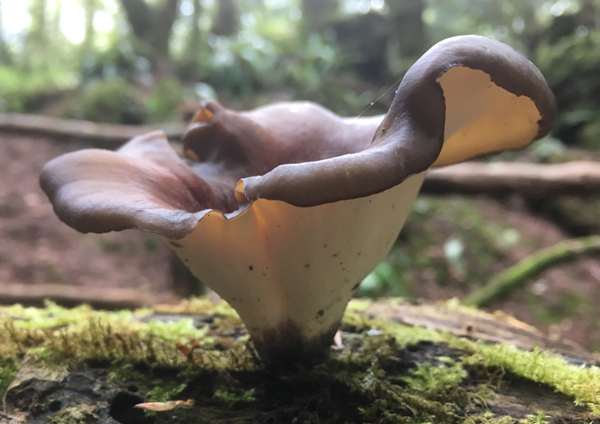
Polyporus durus, until recently better known as Polyporus badius, grows on fallen branches of deciduous trees. The pores of these thin-capped polypores cannot be detached from the upper layer of the cap. Tough and inedible, these are not fungi to gather as food; however, the dried caps are sometimes used as table decorations or as inert contributors to pot pouri.
Because of its brown cap colour, this durable fungus is commonly called the Bay Polypore.
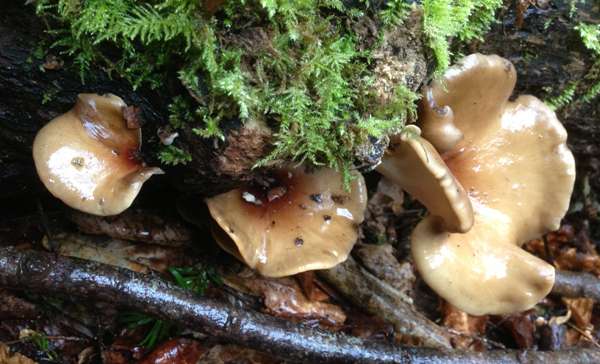
Distribution
Polyporus durus is fairly common and widespread across most of Britain and Ireland. It occurs also throughout mainland Europe and is recorded in many parts of Asia and North America.
Well camouflaged among the fallen brown leaves, these funnel-shaped caps can be difficult to spot, but when you do come across one there is often a small group fruiting on the same log.
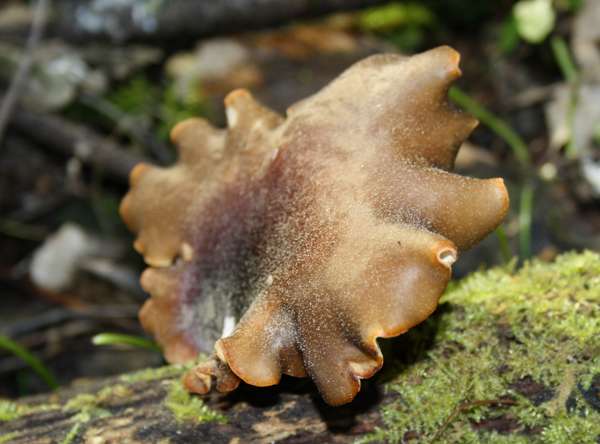
Taxonomic history
The Bay Polypore was described scientifically in 1788 by Timmermans (no biographical details for this authority are known to us), who created its basionym when he gave it the scientific binomial name Boletus durus. (Three years later, in 1801, Christiaan Hendrik Persoon described the same polypore under the scientific name Polyporus badius.)
It was German mycologist Hans Kriesel (born 1931) who in 1984 transferred this species to the genus Polyporus and established its widely-accepted scientific name three years later, in 1801, as Polyporus durus.
Synonyms of Polyporus durus include Boletus durus Timmerm., Boletus badius Pers., Grifola badia (Pers.) Gray, Polyporus badius (Pers.) Schwein., Polyporus picipes Fr., and Polyporellus picipes (Fr.) P. Karst.
Etymology
The generic name Polyporus means 'having many pores', and fungi in this genus do indeed have tubes terminating in pores (usually very small and a lot of them) rather than gills or any other kind of hymenial surface.
The specific epithet durus is a Latin adjective meaning hard, tough or durable. (The synonymous epithet badius also comes from Latin and means bay brown.) The fruitbodies of this tough polypore are slow to rot. As a result you can expect to find Bay Polypores all through summer, albeit with darkened pore surfaces and no longer producing spores.
Identification guide
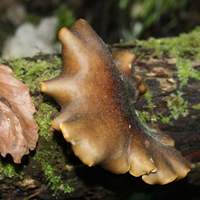 |
CapThe upper surface of the cap of this occasional polypore is smooth, not zoned, and reddish-brown (like a chestnut or a bay mare!) with a much darker centre. Ranging from 5 to 20cm across when fully developed, but often lobed and irregular rather than round, the thin caps are slightly funneled and have wavy margins at maturity. Stem1-3-5cm long (although there is no clear delineation between cap and stem) and 0.5-1.5cm in diameter, the greyish stems are sometimes almost black at the base; tapering towards the base; usually connected eccentrically to the fertile underside of the cap. |
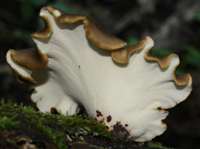 |
Tubes and poresBeneath the cap, the tiny white tubes are packed together at a density of 5-8 per mm (not clearly visible to the naked eye, and hence a magnifying glass is a very useful accessory in the field); they are between 0.5 and 2.5mm deep and terminate in whitish pores that turn yellowish from the margin as they age. The tubes are decurrent with the stem. |
SporesCylindrical or sausage-shaped, smooth, 5-9 x 3-4µm; inamyloid. Spore printWhite. |
|
Odour/taste |
Odour mushroomy but not distinctive; taste mild. |
Habitat & Ecological role |
Saprobic, occasionally on living hardwood trees but mostly on dead hardwood - often fallen branches particularly of Beech. |
Season |
New fruitbodies produce spores from late spring to autumn, but in dryish locations these tough polypores often persist throughout the year. |
Similar species |
Polyporus brumalis is paler are has larger pores but smaller spores. Polyporus ciliatus has a fringed hairy margin. |
Culinary Notes
The white flesh of this polypore fungus is much too tough to be of any culinary interest.
Reference Sources
Mattheck, C., and Weber, K. (2003). Manual of Wood Decays in Trees. Arboricultural Association
Pat O'Reilly (2016). Fascinated by Fungi, First Nature Publishing
BMS List of English Names for Fungi
Paul M. Kirk, Paul F. Cannon, David W. Minter and J. A. Stalpers. (2008). Dictionary of the Fungi; CABI.
Taxonomic history and synonym information on these pages is drawn from many sources but in particular from the British Mycological Society's GB Checklist of Fungi.
Acknowledgements
This page includes pictures kindly contributed by Simon Harding.
Fascinated by Fungi. Back by popular demand, Pat O'Reilly's best-selling 450-page hardback book is available now. The latest second edition was republished with a sparkling new cover design in September 2022 by Coch-y-Bonddu Books. Full details and copies are available from the publisher's online bookshop...

